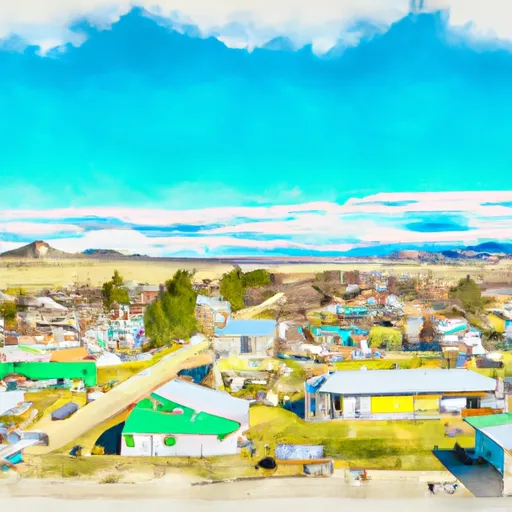-
 Snoflo Premium
Snoflo Premium
Get unlimited access to all our content
With no Ad interruptions! - Start Your Free Trial Login with existing account
Wyola
Eden Index
Climate
7.3
•
Recreation
•
Community
•
Safeguard
2.9/10

Wyola, Montana is a small town located in the southeastern part of the state. It experiences a semi-arid climate with long, cold winters and short, hot summers. The average high temperature in July is around 87°F (31°C), while in January, it drops to about 31°F (-1°C). Wyola receives an average annual precipitation of around 13 inches (33 cm), with most of it occurring in the form of snow during the winter months.
Hydrologically, Wyola is situated near the Tongue River, which flows through the area. This river is an important water source for the region and offers opportunities for fishing and boating. Additionally, there are several small streams and lakes in the surrounding area, providing further options for water-based activities.
Outdoor recreation enthusiasts will find plenty of opportunities in Wyola. The nearby Bighorn National Forest offers a range of activities, including hiking, camping, and wildlife viewing. The forest is home to diverse wildlife, such as elk, deer, and various bird species. Furthermore, the area around Wyola provides opportunities for hunting, horseback riding, and off-roading. With its beautiful natural surroundings and abundance of outdoor activities, Wyola is an ideal destination for nature lovers and adventure seekers.
What is the Eden Index?
The Snoflo Eden Index serves as a comprehensive rating system for regions, evaluating their desirability through a holistic assessment of climate health, outdoor recreation opportunities, and natural disaster risk, acknowledging the profound impact of these factors on livability and well-being.
Climate Health Indicator (CHI): 7.3
Wyola receives approximately
424mm of rain per year,
with humidity levels near 69%
and air temperatures averaging around
7°C.
Wyola has a plant hardyness factor of
4, meaning
plants and agriculture in this region thrive during a short period during spring and early summer. Most
plants will die off during the colder winter months.
By considering the ideal temperature range, reliable water supplies, clean air, and stable seasonal rain or snowpacks, the Climate Health Indicator (CHI) underscores the significance of a healthy climate as the foundation for quality living.
A healthy climate is paramount for ensuring a high quality of life and livability in a region, fostering both physical well-being and environmental harmony. This can be characterized by ideal temperatures, reliable access to water supplies, clean air, and consistent seasonal rain or snowpacks.
Weather Forecast
Streamflow Conditions
Big Horn
Area Rivers
Big Horn
Snowpack Depths
Big Horn
Reservoir Storage Capacity
Big Horn
Groundwater Levels
Recreational Opportunity Index (ROI):
The Recreational Opportunity Index (ROI) recognizes the value of outdoor recreational options, such as parks, hiking trails, camping sites, and fishing spots, while acknowledging that climate plays a pivotal role in ensuring the comfort and consistency of these experiences.
Access to outdoor recreational opportunities, encompassing activities such as parks, hiking, camping, and fishing, is crucial for overall well-being, and the climate plays a pivotal role in enabling and enhancing these experiences, ensuring that individuals can engage in nature-based activities comfortably and consistently.
Camping Areas
| Campground | Campsites | Reservations | Toilets | Showers | Elevation |
|---|---|---|---|---|---|
| Medicine Lodge Lake | 8 | 9,276 ft | |||
| Tie Flume | 27 | 8,350 ft | |||
| Sibley Lake | 20 | 7,996 ft | |||
| Ranger Creek - Paintrock | 17 | 7,672 ft | |||
| Coffeen Park | 6 | 8,504 ft | |||
| Owen Creek | 8 | 8,477 ft | |||
| Two Leggins FAS | None | 2,936 ft | |||
| Cabin Creek Meadows | 26 | 7,637 ft | |||
| Shell Creek | 15 | 7,589 ft | |||
| Paint Rock Lake | 8 | 9,242 ft |
Catastrophe Safeguard Index (CSI):
The Catastrophe Safeguard Index (CSI) recognizes that natural disaster risk, encompassing floods, fires, hurricanes, and tornadoes, can drastically affect safety and the overall appeal of an area.
The level of natural disaster risk in a region significantly affects safety and the overall livability, with climate change amplifying these risks by potentially increasing the frequency and intensity of events like floods, fires, hurricanes, and tornadoes, thereby posing substantial challenges to community resilience and well-being.
Community Resilience Indicator (CRI):
The Community Resilience Indicator (CRI) recognizes that education, healthcare, and socioeconomics are crucial to the well-being of a region. The CRI acknowledges the profound impact of these elements on residents' overall quality of life. By evaluating educational resources, healthcare accessibility, and economic inclusivity, the index captures the essential aspects that contribute to a thriving community, fostering resident satisfaction, equity, and social cohesion.

